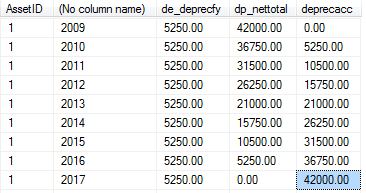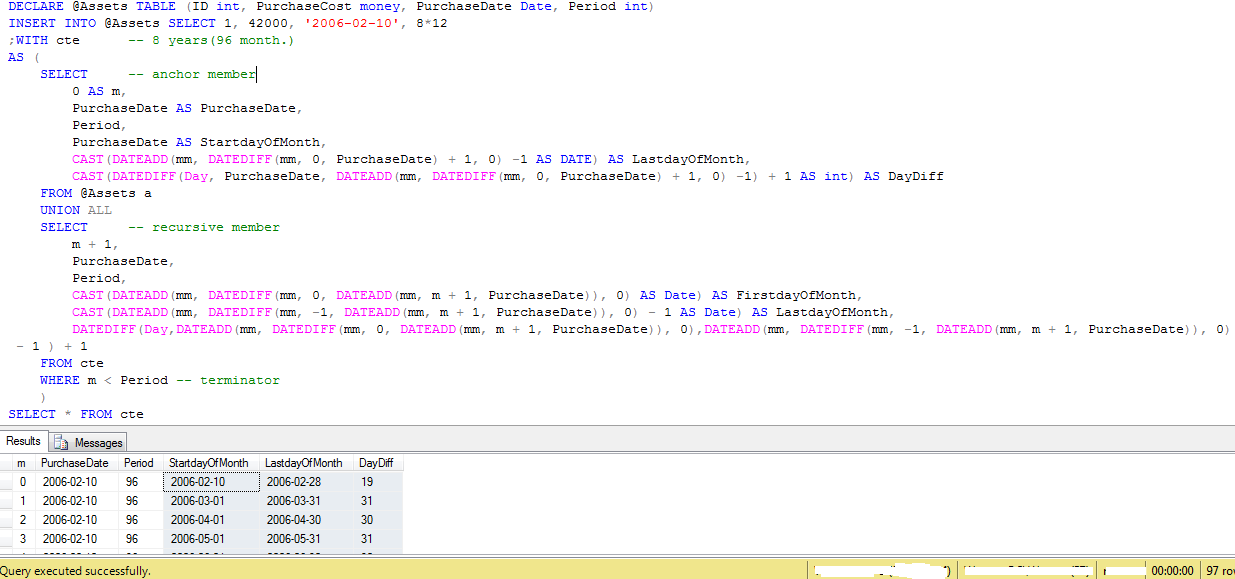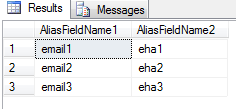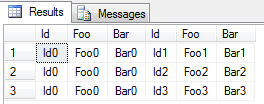 |
รบกวนสอบถามผู้รู้เกี่ยวกับการคิดค่าเสื่อมครุภัณฑ์แบบเส้นตรงค่ะ ต้องเขียนโค้ดยังไงค่า |
| |
 |
|
|
 |
 |
|
สรุปศูตร มาให้คร่าว ๆ ครับ เดียวจะช่วยเขียน Code ให้
|
 |
 |
 |
 |
| Date :
2014-04-22 09:34:00 |
By :
mr.win |
|
 |
 |
 |
 |
|
|
 |
 |
|
 |
 |
 |
|
|
 |
 |
|
การคำนวณค่าเสื่อมน่ะค่ะ
=>กรณีที่ 1 ค่าเสื่อมกรณีคิด 1 ปี = ราคา/อายุการใช้งาน
เช่นจากรูปด้านบน ค่าเสื่อมปี 2550 => 42,000/8 = 5,250
=>กรณีที่ 2 ค่าเสื่อมกรณีคิดไม่ถึง 1 ปี = (ราคา/อายุการใช้งาน)*(วัน/366)
เช่นจากรูปด้านบน ค่าเสื่อมปี 2549 => (42,000/8) * (248/366) = 3,557
สงสัยด้วยว่าถ้าคิดไม่ถึงปีต้องนับจากรับครุภัณฑ์มาจนถึงปี งบประมาณต้องทำไงค่ะ ฐานข้อมูลต้องเพิ่มมั๊ยค่ะ
เช่น คิดปี 2549 แต่วันรับไม่ถึงปี รับ 10 กพ. 49 ต้องคิดคำนวณ 30 กย. 49 ซึ่งไม่ถึงปี ต้องเก็บค่ายังไงค่ะ
ปณ. การคิดคำนวณนั้นจะคิด 1 ตค.ของปี- 30 กย.ของปี เช่น 1 ต.ค. 2549 - 30 ก.ย. 2550 ค่ะ
รบกวนด้วยน่ะค่ะ ขอบคุณมากค่ะ +_+
|
 |
 |
 |
 |
| Date :
2014-04-23 17:47:30 |
By :
nungna11 |
|
 |
 |
 |
 |
|
|
 |
 |
|
 |
 |
 |
|
|
 |
 |
|
1. ลองทำความเข้าใจกับ Link ข้างล่างนี้ก่อนครับ
ถ้าคุณเข้าใจก็ข้ามไปข้อที่ 2. ได้เลยครับ
http://www.esg.co.th/esg/index.php?fi=no&page=articles&lev=2&ct=114&lang=en
http://www.youtube.com/watch?v=dvfCBSanabs
http://www.youtube.com/watch?v=vKa5wGPAi9U
2. หลังจากที่คุณเข้าใจ (ในระดับหนึ่งแล้ว) จะเขียนโปรแกรมหรือว่าจะเขียน Query มันก็ไม่ใช่เรื่องยาก
----- 2.1 ผมมีคำถามสั้นฯ : จะเขียน Query หารากที่ 8 ของ 42,000.00 ได้อย่างไร? (คำตอบคือ 3.78)
----- 2.1 ?
[x] คิดเสียว่า โปรแกรมเมอร์คุยกับโปรแกรมเมอร์ (วิธีการมีร้อยแปดพันเก้า)
|
 |
 |
 |
 |
| Date :
2014-04-24 14:22:22 |
By :
love9713 |
|
 |
 |
 |
 |
|
|
 |
 |
|
 |
 |
 |
|
|
 |
 |
|
 ตอบความคิดเห็นที่ : 4 เขียนโดย : itpcc เมื่อวันที่ 2014-04-24 20:21:00 ตอบความคิดเห็นที่ : 4 เขียนโดย : itpcc เมื่อวันที่ 2014-04-24 20:21:00
ผมพึ่งนึกออกครับ
สังเกตุไหมว่าโปรแกรม Excel มีฟังก์ชั่นมากมายให้เราเลือกใช้งาน อทิเช่น
Financial Function
--- PV()
--- NPV()
--- NB()
--- VDB()
--- SLN() ค่าเสื่อมราคาแบบเส้นตรง
--- more...
ลองไปดาวโหลด http://ilspy.net/ เอามาเปิดไฟล์ Microsoft VisualBasic.dll เพื่อดู Sourcecode ของมัน
(ไมโครซอฟท์คิดมันน่าจะผิดน้อยกว่าที่เราคิดเอง ผมเชื่อเช่นนี้)
|
 |
 |
 |
 |
| Date :
2014-04-26 07:57:31 |
By :
love9713 |
|
 |
 |
 |
 |
|
|
 |
 |
|
 |
 |
 |
|
|
 |
 |
|
ขอบคุณมากค่ะสำหรับคำแนะนำ 
|
 |
 |
 |
 |
| Date :
2014-04-26 12:52:34 |
By :
nungna11 |
|
 |
 |
 |
 |
|
|
 |
 |
|
 |
 |
 |
|
|
 |
 |
|
อ.มานพกล่าวเอาไว้ว่าในเมืองไทย ร้อยละ 99.99 นิยมคิดค่าเสื่อมราคาแบบเส้นตรง (SLM)
ในกรณี ครบปี ยกตัวอย่างได้ดังนี้
สมมุติโจทย์ตัวอย่าง วันที่ 2010-10-01 ซื้อนาฬิกา ดิลโด้ มา 1 เรือน ราคา 4,2000 บาท และมีอายุการใช้งาน 8 ปี มูลค่าซากเท่ากับ 0 บาท
คำนวณแบบครบปี
Code (SQL)
DECLARE @yourAssets TABLE (ID INT, de_perunit MONEY, dp_expired INT)
INSERT INTO @yourAssets
SELECT 1, 42000, 8
;WITH cte (AssetID, [Years], dp_expired
,de_deprecfy, dp_nettotal, deprecacc
) AS (
SELECT ID, 0, dp_expired
,ROUND(de_perunit/dp_expired, 2)
,de_perunit, CAST(0 AS MONEY)
FROM @yourAssets
UNION ALL
SELECT AssetID, [Years]+1, dp_expired
,CASE [Years]+1 WHEN dp_expired THEN dp_nettotal ELSE de_deprecfy END
,CASE [Years]+1 WHEN dp_expired THEN CAST(0 AS MONEY) ELSE dp_nettotal - de_deprecfy END
,CASE [Years]+1 WHEN dp_expired THEN deprecacc + dp_nettotal ELSE deprecacc + de_deprecfy END
FROM cte WHERE [Years] < dp_expired)
SELECT AssetID, [Years]+ 2009, de_deprecfy, dp_nettotal, deprecacc
FROM cte
ORDER BY AssetID, [Years]
|
 |
 |
 |
 |
| Date :
2014-04-28 06:28:20 |
By :
love9713 |
|
 |
 |
 |
 |
|
|
 |
 |
|
 |
 |
 |
|
|
 |
 |
|
#NO 10 Output Sample

|
 |
 |
 |
 |
| Date :
2014-04-28 06:30:51 |
By :
love9713 |
|
 |
 |
 |
 |
|
|
 |
 |
|
 |
 |
 |
|
|
 |
 |
|
ข้อสังเกตุ คำว่า ไม่ครบปี/ไม่ครบเดือน
เราจะคำนวณเฉพาะ ปีแรก/เดือนแรก หรือ ปีสุดท้าย/เดือนสุดท้าย เท่านั้นครับ นอกเหนือจากนี้ ก็คำนวณแบบปกติ เต็มปี/เต็มเดือน
สิ่งที่ควรจะรู้ สมมุติว่าวันปัจจุบันคือ
Code (MSSQL)
DECLARE @Todays DATETIME = '2010-10-01' -- วันที่ 1 ตุลาคม พ.ศ. 2553
1. วิธีหาวันแรกของเดือน
Code (MSSQL)
SELECT DATEADD(MM, DATEDIFF(MM, 0, @Todays), 0) AS [FirstDayOfMonth] -- 2010-10-01
2. วิธีหาวันสุดท้ายของเดือน
Code (SQL)
SELECT DATEADD(MM, DATEDIFF(MM, -1, @Todays), 0) - 1 AS [LastDayOfMonth] -- 2010-10-31
3. นับวันแบบนับต้นไม่นับปลาย จากวันที่ของเดือน - วันสุดท้ายของเดือนนั้นฯ ตัวอย่างเช่น
จากวันที่ 5 ตุลาคม พ.ศ. 2553 - วันที่ 31 ตุลาคม พ.ศ. 2553 มีกี่วัน (คำตอบคือ 26 วัน)
Code (MSSQL)
SELECT DATEDIFF(Day, DATEADD(d, 5, @Todays), DATEADD(MONTH, DATEDIFF(MONTH, -1, @Todays), -1)) + 1 -- 26 วัน
คำนวณในกรณีไม่เต็มเดือนไม่เต็มปี
...
...
...
Good Luck.
|
 |
 |
 |
 |
| Date :
2014-04-28 08:54:29 |
By :
love9713 |
|
 |
 |
 |
 |
|
|
 |
 |
|
 |
 |
 |
|
|
 |
 |
|
จาก #NO 12 คำนวณในกรณีไม่เต็มเดือนไม่เต็มปี
ก่อนจะไปถึงจุดนั้้น
ผมจะเล่าเรื่องสนุกสนุกให้คุณฟัง เพื่อให้คุณเข้าใจ (ไม่ได้มีเจตนาที่จะลบหลู่อันใดก็ตามครับ)
(คุณต้องเข้าใจสิ่งเหล่านี้ เพื่อประโยชน์ของตัวคุณเองครับ)
เขาเล่ากันมาว่า "ดาราสาวสาวสวยสวยทั้งหลายแหล่ ที่เสียชีวิตก่อนวัยอันควยด้วยสาเหตุใดก็ตาม"
ผู้มีอำนาจแต่ไร้ปัญญา(นิติศาสตร์/รัฐศาสตร์/ลามกศาสตร์ เคยตัดสินไร้มาตราฐานเอาไว้ว่า
"จะให้ขึ้นไปสรวงสวรรค์ก็ไม่สมควร"
"จะให้ไปลงนรกก็ยิ่งไม่เหมาะสม ชาวกรวยคงไม่พอใจเป็นแน่แท้"
ส่งไปอยู่บนดาวพลูโตก็แล้วกันนะสาวสาว นี่คือที่มาและที่ไป พยายามลองทำความเข้าใจดูครับ
(Copy Code ด้านล่างนี้ไปรันบน SSMS)
ปัจจุบันผมอาศัยอยู่บนดาวพลูโต
Code (MSSQL)
DECLARE @TableResult TABLE (ListDate DATE, Kanok_Price MONEY)
DECLARE @ToDays DATETIME = '2010-10-01'
DECLARE @FirstDateOfMonth DATETIME = DATEADD(MONTH, DATEDIFF(MONTH, 0, @ToDays), 0)
DECLARE @LastDateOfMonth DATETIME = DATEADD(MONTH, DATEDIFF(MONTH, -1, @ToDays), -1)
WHILE @FirstDateOfMonth <= @LastDateOfMonth
BEGIN
INSERT INTO @TableResult VALUES (@FirstDateOfMonth, 2500 + 1000)
SET @FirstDateOfMonth = @FirstDateOfMonth + 1
END
SELECT *
FROM @TableResult
|
 |
 |
 |
 |
| Date :
2014-04-28 09:19:01 |
By :
love9713 |
|
 |
 |
 |
 |
|
|
 |
 |
|
 |
 |
 |
|
|
 |
 |
|
จาก #NO No. 12 ผมเสียดายที่ผมตอบผิดโดยตั้งใจ/ไม่ตั้งใจ คำตอบคือ 26 วัน
และไม่มีคนนับให้ผม มันต้องได้ 27 วัน (ความถูกต้องตามหลักบัญชี)
|
 |
 |
 |
 |
| Date :
2014-04-28 18:34:22 |
By :
love9713 |
|
 |
 |
 |
 |
|
|
 |
 |
|
 |
 |
 |
|
|
 |
 |
|
ในกรณีไม่ครบปีหลักการของคุณใช้เต็มเดือนและวันเฉลี่ย (31 วัน) ยกตัวอย่างเช่น
248 วันมาจาก 2006/09/30 - 2006/02/10 = 8 เดือน แปลงเป็นวันได้ = 8 เดือน x 31 วัน = 248 วัน
แล้วเข้าสูตรคำนวนตามปกติ (แบบนี้ง่ายง่าย)
คำนวนค่าเสื่อมไม่ครบปี (คำนวนเป็นวันตามจริง)
SQL Query ด้านล่างนี้ใช้หลักการเดียวกับโปรแกรม Express
Book Value (มูลค่าทางบัญชี) และ Cummulative Depreciation (ค่าเสื่อมสะสม) ดู #NO 10, 11
(มันต่างกันแค่คำนวนครบปีและไม่ครบปีเท่านั้นเองครับ)
ผมไม่หวังว่าคุณจะเข้าใจ แต่ถ้าคุณพยายามมากพอจนคุณเข้าใจ มันก็เป็นประโยชน์สำหรับตัวคุณเอง ครับ

|
 |
 |
 |
 |
| Date :
2014-05-02 13:53:35 |
By :
love9713 |
|
 |
 |
 |
 |
|
|
 |
 |
|
 |
 |
 |
|
|
 |
 |
|
จาก #NO 7 อยากรู้ว่า NameSpace Microsoft.VisualBasic.Financial (Function Excel) มันเขียนอย่างไร?
ไม่รู้ว่าใครลอกเลียนใคร ระหว่าง MS และ Novell
Code (VB.NET)
' Financial.vb
'
' Author:
' Mizrahi Rafael ([email protected])
' Boris Kirzner ([email protected])
'
'
' Copyright (C) 2002-2006 Mainsoft Corporation.
' Copyright (C) 2004-2006 Novell, Inc (http://www.novell.com)
'
' Permission is hereby granted, free of charge, to any person obtaining
' a copy of this software and associated documentation files (the
' "Software"), to deal in the Software without restriction, including
' without limitation the rights to use, copy, modify, merge, publish,
' distribute, sublicense, and/or sell copies of the Software, and to
' permit persons to whom the Software is furnished to do so, subject to
' the following conditions:
'
' The above copyright notice and this permission notice shall be
' included in all copies or substantial portions of the Software.
'
' THE SOFTWARE IS PROVIDED "AS IS", WITHOUT WARRANTY OF ANY KIND,
' EXPRESS OR IMPLIED, INCLUDING BUT NOT LIMITED TO THE WARRANTIES OF
' MERCHANTABILITY, FITNESS FOR A PARTICULAR PURPOSE AND
' NONINFRINGEMENT. IN NO EVENT SHALL THE AUTHORS OR COPYRIGHT HOLDERS BE
' LIABLE FOR ANY CLAIM, DAMAGES OR OTHER LIABILITY, WHETHER IN AN ACTION
' OF CONTRACT, TORT OR OTHERWISE, ARISING FROM, OUT OF OR IN CONNECTION
' WITH THE SOFTWARE OR THE USE OR OTHER DEALINGS IN THE SOFTWARE.
'
Imports Microsoft.VisualBasic.CompilerServices
Imports System
Namespace Microsoft.VisualBasic
<StandardModule()> _
Public NotInheritable Class Financial
Public Shared Function DDB(ByVal Cost As Double, ByVal Salvage As Double, _
ByVal Life As Double, ByVal Period As Double, _
Optional ByVal Factor As Double = 2.0) As Double
If Period > Life Or Factor <= 0 Or Salvage < 0 Or Life < 0 Or Period <= 0 Then
Throw New ArgumentException("Argument 'Factor' is not a valid value.")
End If
' LAMESPEC: MSDN claims the exception should be thrown in this case
'If Cost < 0 Then
'Throw New ArgumentException("Argument 'Factor' is not a valid value.")
'End If
' Below we use power of (Period - 1).
' Tested Period < 1 and it behaves like Period = 1
If Period < 1 Then
Period = 1
End If
Dim Rate As Double = Factor / Life
Dim PreviousValue As Double = Cost * (1 - Rate) ^ (Period - 1)
PreviousValue = Math.Max(PreviousValue, Salvage)
Dim CurrentValue As Double = Cost * (1 - Rate) ^ Period
CurrentValue = Math.Max(CurrentValue, Salvage)
Return PreviousValue - CurrentValue
End Function
Public Shared Function SLN(ByVal Cost As Double, ByVal Salvage As Double, _
ByVal Life As Double) As Double
If Life = 0 Then
Throw New ArgumentException("Argument 'Life' cannot be zero.")
End If
Return ((Cost - Salvage) / Life)
End Function
Public Shared Function SYD(ByVal Cost As Double, ByVal Salvage As Double, _
ByVal Life As Double, ByVal Period As Double) As Double
If Salvage < 0 Then
Throw New ArgumentException("Argument 'Salvage' must be greater than or equal to zero.")
End If
If Period > Life Then
Throw New ArgumentException("Argument 'Period' must be less than or equal to argument 'Life'.")
End If
If Period <= 0 Then
Throw New ArgumentException("Argument 'Period' must be greater than zero.")
End If
Return ((Cost - Salvage) * (Life - Period + 1) * 2 / Life) / (Life + 1)
End Function
Public Shared Function FV(ByVal Rate As Double, ByVal NPer As Double, ByVal Pmt As Double, _
Optional ByVal PV As Double = 0, Optional ByVal Due As DueDate = DueDate.EndOfPeriod) As Double
If NPer < 0 Then
If Due = DueDate.EndOfPeriod Then
Due = DueDate.BegOfPeriod
Else
Due = DueDate.EndOfPeriod
End If
Return FV(1 / (1 + Rate) - 1, -NPer, -Pmt, PV, Due)
End If
If NPer = 0 Or Rate = 0 Then
Return -(PV + Pmt * NPer)
End If
If Due = DueDate.BegOfPeriod Then
Pmt = Pmt * (1 + Rate)
End If
Dim ExpRate As Double = (1 + Rate) ^ NPer
Return -(PV * ExpRate + Pmt * (ExpRate - 1) / Rate)
End Function
Public Shared Function Rate(ByVal NPer As Double, ByVal Pmt As Double, ByVal PV As Double, _
Optional ByVal FV As Double = 0, Optional ByVal Due As DueDate = DueDate.EndOfPeriod, _
Optional ByVal Guess As Double = 0.1) As Double
Throw New NotImplementedException
End Function
Public Shared Function IRR(ByRef ValueArray() As Double, Optional ByVal Guess As Double = 0.1) As Double
Throw New NotImplementedException
End Function
Public Shared Function MIRR(ByRef ValueArray() As Double, ByVal FinanceRate As Double, _
ByVal ReinvestRate As Double) As Double
If FinanceRate <= -1 Then
Throw New ArgumentException("Argument 'FinanceRate' is not a valid value.")
End If
If ReinvestRate <= -1 Then
Throw New ArgumentException("Argument 'ReinvestRate' is not a valid value.")
End If
Dim pnpv1 As Double = PNPV(ValueArray, ReinvestRate)
Dim nnpv1 As Double = NNPV(ValueArray, FinanceRate)
Dim n As Integer = ValueArray.Length
Dim intermediate As Double = (-pnpv1 * (1 + ReinvestRate) ^ n) / (nnpv1 * (1 + FinanceRate))
Dim result As Double = Math.Abs(intermediate) ^ (1 / (n - 1)) - 1
If intermediate < 0 Then
Return -result
Else
Return result
End If
End Function
Private Shared Function PNPV(ByVal ValueArray() As Double, ByVal Rate As Double) As Double
Dim result As Double = 0
For i As Integer = 1 To ValueArray.Length
Dim value As Double = ValueArray(i - 1)
If value >= 0 Then
result = result + value / (1 + Rate) ^ i
End If
Next
Return result
End Function
Private Shared Function NNPV(ByVal ValueArray() As Double, ByVal Rate As Double) As Double
Dim result As Double = 0
For i As Integer = 1 To ValueArray.Length
Dim value As Double = ValueArray(i - 1)
If value < 0 Then
result = result + value / (1 + Rate) ^ i
End If
Next
Return result
End Function
Public Shared Function NPer(ByVal Rate As Double, ByVal Pmt As Double, ByVal PV As Double, _
Optional ByVal FV As Double = 0, Optional ByVal Due As DueDate = DueDate.EndOfPeriod) As Double
If Rate = -1 Then
Throw New ArgumentException("Argument 'Rate' is not a valid value.")
End If
If Pmt = 0 Then
If Rate = 0 Then
Throw New ArgumentException("Argument 'Pmt' is not a valid value.")
Else
Throw New ArgumentException("Cannot calculate number of periods using the arguments provided.")
End If
End If
Dim iDue As Integer = Due
Dim tmp As Double = (Pmt * (1D + Rate * iDue)) / Rate
Dim ret As Double = Math.Log((tmp - FV) / (tmp + PV)) / Math.Log(1D + Rate)
Return ret
'If Rate = -1 Then
' Throw New ArgumentException("Argument 'Rate' is not a valid value.")
'End If
'If Pmt = 0 Then
' If Rate = 0 Then
' Throw New ArgumentException("Argument 'Pmt' is not a valid value.")
' Else
' Throw New ArgumentException("Cannot calculate number of periods using the arguments provided.")
' End If
'End If
'Dim current As Double = 0
'' FIXME : what is the meaning of double period value ?
'Dim pperiod As Integer = 0
'Dim fperiod As Integer = 0
'Dim apmt As Double = Math.Abs(Pmt)
'If PV <> 0 Then
' If PV * Pmt < 0 Then
' current = Math.Abs(PV)
' If Due = DueDate.BegOfPeriod Then
' current = current - current * Rate
' End If
' While current > 0
' current = current + current * Rate
' current = current + apmt
' pperiod = pperiod + 1
' End While
' Else
' current = apmt
' If Due = DueDate.BegOfPeriod Then
' PV = PV * (1 + Rate)
' End If
' While current < Math.Abs(PV)
' current = current + current * Rate
' current = current + apmt
' pperiod = pperiod - 1
' End While
' End If
'End If
'If FV <> 0 Then
' If FV * Pmt < 0 Then
' current = apmt
' If Due = DueDate.EndOfPeriod Then
' current = 0
' End If
' While current < Math.Abs(FV)
' current = current + current * Rate
' current = current + apmt
' fperiod = fperiod + 1
' End While
' Else
' fperiod = 1
' current = Math.Abs(FV)
' If Due = DueDate.BegOfPeriod Then
' current = current - current * Rate
' End If
' While current > 0
' current = current + current * Rate
' current = current - apmt
' fperiod = fperiod - 1
' End While
' End If
'End If
'Return pperiod + fperiod
End Function
Public Shared Function IPmt(ByVal Rate As Double, ByVal Per As Double, ByVal NPer As Double, _
ByVal PV As Double, Optional ByVal FV As Double = 0, _
Optional ByVal Due As DueDate = DueDate.EndOfPeriod) As Double
If Per <= 0 Or Per > NPer Or NPer < 0 Then
Throw New ArgumentException("Argument 'Per' is not a valid value.")
End If
If Per = 1 AndAlso Due = DueDate.BegOfPeriod Then
Return 0 ' The formula below doesn't cover this special case
End If
Dim Pmt As Double = Financial.Pmt(Rate, NPer, PV, FV, Due)
Dim PreviousPV As Double = Financial.FV(Rate, Per - 1, Pmt, PV, Due)
If Due = DueDate.BegOfPeriod Then
PreviousPV = PreviousPV / (1 + Rate)
End If
Return PreviousPV * Rate
End Function
Public Shared Function Pmt(ByVal Rate As Double, ByVal NPer As Double, ByVal PV As Double, _
Optional ByVal FV As Double = 0, _
Optional ByVal Due As DueDate = DueDate.EndOfPeriod) As Double
If NPer = 0 Then
Throw New ArgumentException("Argument 'NPer' is not a valid value.")
End If
If NPer < 0 Then
Return -Pmt(Rate, -NPer, FV, PV, Due)
End If
If Rate = 0 Then
Return -(PV + FV) / NPer
End If
Dim ExpRate As Double = (1 + Rate) ^ NPer
Dim dfpv As Double = (1 - 1 / ExpRate) / Rate
Dim dffv As Double = (ExpRate - 1) / Rate
If Due = DueDate.BegOfPeriod Then
dffv = dffv * (1 + Rate)
dfpv = dfpv * (1 + Rate)
End If
Return -(PV / dfpv + FV / dffv)
End Function
Public Shared Function PPmt(ByVal Rate As Double, ByVal Per As Double, ByVal NPer As Double, _
ByVal PV As Double, Optional ByVal FV As Double = 0, _
Optional ByVal Due As DueDate = DueDate.EndOfPeriod) As Double
Return Pmt(Rate, NPer, PV, FV, Due) - IPmt(Rate, Per, NPer, PV, FV, Due)
End Function
Public Shared Function NPV(ByVal Rate As Double, ByRef ValueArray() As Double) As Double
If ValueArray Is Nothing Then
Throw New ArgumentException("Argument 'ValueArray' is Nothing.")
End If
If Rate = -1 Then
Throw New ArgumentException("Argument 'Rate' is not a valid value.")
End If
Dim result As Double = 0
For i As Integer = 1 To ValueArray.Length
result = result + (ValueArray(i - 1) / ((1 + Rate) ^ i))
Next
Return result
End Function
Public Shared Function PV(ByVal Rate As Double, ByVal NPer As Double, ByVal Pmt As Double, _
Optional ByVal FV As Double = 0, _
Optional ByVal Due As DueDate = DueDate.EndOfPeriod) As Double
Dim result As Double = 0
Dim d As Double = (1 + Rate) ^ NPer
Dim n As Double
If Due = DueDate.EndOfPeriod Then
n = -FV - Pmt * (d - 1) / Rate
Else
n = -FV - Pmt * (1 + Rate) * (d - 1) / Rate
End If
result = n / d
Return result
End Function
Public Shared Function LikeYet() As String
Return "Fuck"
End Function
End Class
End Namespace
|
 |
 |
 |
 |
| Date :
2014-05-04 12:07:01 |
By :
love9713 |
|
 |
 |
 |
 |
|
|
 |
 |
|
 |
 |
 |
|
|
 |
 |
|
จาก #NO 12
สิ่งที่ควรจะรู้ เพิ่มเติม ปี ค.ศ. xxxx มีกี่วัน
xxxx
Code (SQL)
SELECT DATEPART(dy, CAST(YEAR('2012-02-28') AS CHAR(4)) + '-12-31') AS DaysOfYear /* 366 วัน*/
ผลพลอยได้จาก xxxx คือ [color=red]IsLeapYear[/color]
Code (SQL)
SELECT CASE DATEPART(dy, CAST(YEAR(2012-02-28) AS char(4)) + '-12-31') WHEN 366 THEN 'true' ELSE 'false' END
/*true*/
|
 |
 |
 |
 |
| Date :
2014-05-04 12:14:24 |
By :
love9713 |
|
 |
 |
 |
 |
|
|
 |
 |
|
 |
 |
 |
|
|
 |
 |
|
แก้ไข #NO 18 IsLeapYear
YEAR(2012-02-28) แก้ไขเป็น YEAR('2012-02-28')
Code (SQL)
SELECT CASE DATEPART(dy, CAST(YEAR('2012-02-28') AS char(4)) + '-12-31') WHEN 366 THEN 'true' ELSE 'false' END
/*true*/
|
 |
 |
 |
 |
| Date :
2014-05-04 12:25:00 |
By :
love9713 |
|
 |
 |
 |
 |
|
|
 |
 |
|
 |
 |
 |
|
|
 |
 |
|
จาก #NO 17 บรรทัดที่ 344 - 346 ผมไม่ได้มั่ว (แต่ผมต้องการสื่อถึงอะไรบางอย่าง/มันมีความหมายซ่อนอยู่ในนั้น)
|
 |
 |
 |
 |
| Date :
2014-05-04 12:42:39 |
By :
love9713 |
|
 |
 |
 |
 |
|
|
 |
 |
|
 |
 |
 |
|
|
 |
 |
|
จาก #NO 22 ขยายความ CROSS APPLY ฉบับโปรแกรมเมอร์คุยกับโปรแกรมเมอร์
Code (SQL)
SELECT *
FROM (VALUES ('email1', 'eha1'), ('email2', 'eha2'), ('email3', 'eha3')) AS AliasTableName (AliasFieldName1, AliasFieldName2)
ผลลัพธ์

Code (SQL)
SELECT * FROM (SELECT Id,
Foo,
Bar
FROM (VALUES ('Id0', 'Foo0', 'Bar0')) AS AliasTableNameX (Id, Foo, Bar)) AS X
CROSS APPLY
(SELECT *
FROM (VALUES('Id1', 'Foo1', 'Bar1'),
('Id2', 'Foo2', 'Bar2'),
('Id3', 'Foo3', 'Bar3')) AS AliasTableNameY(Id, Foo, Bar)) AS Y
ผลลัพธ์

|
 |
 |
 |
 |
| Date :
2014-05-05 11:04:45 |
By :
love9713 |
|
 |
 |
 |
 |
|
|
 |
 |
|
 |
 |
 |
|
|
 |
 |
|
จาก #NO 24 อันนี้คือข้อแตกต่างระหว่าง CROSS APPLY และ INNER JOIN
Code (SQL)
SELECT * FROM (SELECT Id,
Foo,
Bar
FROM (VALUES ('Id0', 'Foo0', 'Bar0')) AS AliasTableNameX (Id, Foo, Bar)) AS X
CROSS APPLY
(SELECT TOP 1 *
FROM (VALUES('Id1', 'Foo1', 'Bar1'),
('Id2', 'Foo2', 'Bar2'),
('Id3', 'Foo3', 'Bar3')) AS AliasTableNameY(Id, Foo, Bar)) AS Y
ผลลัพธ์

|
 |
 |
 |
 |
| Date :
2014-05-05 11:09:06 |
By :
love9713 |
|
 |
 |
 |
 |
|
|
 |
 |
|
 |
 |
 |
|
|
 |
 |
|
อยากรู้โค้ด php อ่ะครับ
|
 |
 |
 |
 |
| Date :
2016-12-11 15:30:45 |
By :
pudjaza0014 |
|
 |
 |
 |
 |
|
|
 |
 |
|
 |
 |
|
|